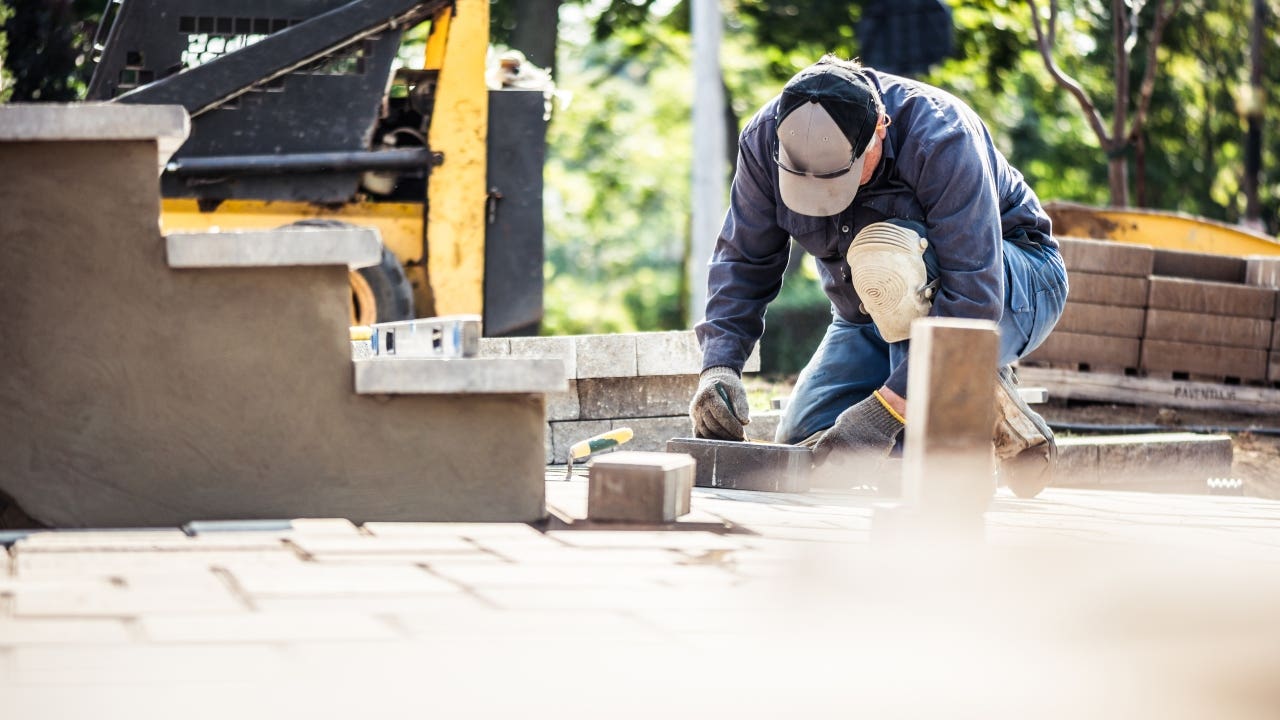Refinancing for home improvement: How it works

The Bankrate promise
At Bankrate we strive to help you make smarter financial decisions. While we adhere to strict , this post may contain references to products from our partners. Here's an explanation for .
Key takeaways
- A cash-out refinance can be a good fit for a homeowner who needs a sizable sum for a renovation project.
- Cash-out refinances come with short-term considerations such as upfront closing costs and the long-term implications of greater debt and a new interest rate.
- Using the funds from a cash-out refinance for a home renovation project can create the potential for a tax deduction.
- Alternatives to a cash-out refinance include home equity loans, HELOCs and credit cards with a 0 percent APR introductory period.
While annual spending on home improvements is projected to decline by 7 percent by the third quarter of 2024, according to a report by the Joint Center for Housing Studies of Harvard University, making strategic improvements can substantially increase your home’s value. If you don’t have the savings to cover the project — or don’t want to deplete them to do so — it’s worth exploring how refinancing your mortgage can help pay for it. Refinancing for home improvement involves a specific type of transaction, called a cash-out refinance.
How to refinance for home improvements
A major, high-cost renovation like adding an in-law apartment or putting on an addition often necessitates a cash-out refinance.— Greg McBride, CFA , chief financial analyst for Bankrate
In a cash-out refinancing (cash-out refi for short), you replace your existing mortgage with a larger home loan, taking the difference out in ready money. The amount you can get is based on your home’s worth and how much of it you actually own. Most lenders require that the size of your new loan equal no more than 80 percent of the home’s value, a figure known as the loan-to-value (LTV) ratio.
Here’s a step-by-step breakdown of how to refinance for home improvements:
- Step 1: Identify your home’s current market value and mortgage balance. Let’s say you still owe $70,000 on your home, which has an appraised value of $250,000, and you decide to add an in-law apartment to your house. With a cash-out refinance, you can get a new mortgage of up to $200,000, which would pay off the $70,000 debt and leave you with $130,000 (a bit less than that after closing costs) to use for the renovation. Why $200,000? Because in this case, with your home worth $250,000, $200,000 keeps you within an 80 percent LTV ratio.
- Step 2: Use loan proceeds for renovations. On closing day, when the new loan is finalized, the lender will give you a check for your cash-out funds. You can then use the money to cover the costs of your planned home improvements.
- Step 3: Begin repaying the loan. Once you receive the proceeds, you must start repaying the money — both the mortgage and the cash-out funds — in monthly installments, just as you did your old mortgage. Your new mortgage will have different terms, possibly higher monthly payments and a different interest rate — sometimes higher than what you had originally.
“There are a number of different avenues where a homeowner can tap into the money needed for a $20,000 renovation, but a major, high-cost renovation like adding an in-law apartment or putting on an addition often necessitates a cash-out refinance,” says Greg McBride, chief financial analyst at Bankrate.
What can you use the cash for?
The proceeds from a cash-out refinance can be used however you wish, but not all home improvements deliver the same return on investment (ROI). It’s a good idea to focus on projects that add the most value and provide the best ROI.
Because people spend so much time in their kitchen, buyers often want an updated or modern kitchen. Minor kitchen improvements can have a big impact on your home’s appeal, according to the trade publication Remodeling. The 2024 national average ROI for a minor kitchen improvement project is about 96.1 percent. Similarly, bathroom upgrades can have a big impact, and a midrange-budget bath remodel offers a 73.7 percent ROI.
Qualifying for a cash-out refinance
A cash-out refinance is a new mortgage, so you will have to qualify. That means meeting the lender’s criteria — even if you’re using the lender of your original loan. Among the requirements:
- Good or excellent credit: A good or excellent credit score is typically 670 or higher.
- Low debt-to-income (DTI) ratio: Your DTI is your total monthly income relative to your total monthly debts. Ideally, lenders will want this number to be around 36 percent, though some will accept DTIs of 43 percent.
- Loan-to-value ratio: Most lenders require that you have an LTV ratio below 80 percent. To determine your LTV, divide your outstanding mortgage balance by the market value of your home, then convert that number to a percentage.
- Decent income: In addition to adequate home equity, you’ll also need consistent income to qualify for a cash-out refinance. Income requirements vary by lender. In today’s high-rate environment, you’re going to need to demonstrate that you’re earning enough money to cover higher payments. It’s a problem for a number of borrowers: A recent report from the Consumer Financial Protection Bureau showed that lenders denied applications for mortgages due to insufficient income at the highest rates since 2018.
Despite cash-out refinance rates hovering slightly over 7 percent, mortgages are still among the cheapest loans you can get — credit cards and personal loans often have higher rates. However, you’ll want to have a concrete understanding of your LTV ratio before applying to a lender.
Say you have an LTV ratio of 50 percent and do a cash-out refinance to pay for a renovation, and the new loan terms put your LTV ratio at 70 percent. That still looks good in the eyes of the lender. However, if you need more money and wind up with an LTV ratio above 80 percent after you add on the cash, you may encounter some trouble.
Pros and cons of using a cash-out refinance for home improvements
Pros
- Access to a big chunk of cash: You can access the money to improve your home by tapping into your home — specifically, the home equity stake you’ve already built.
- Upgrades can translate to an uptick in value: Depending on the type of renovation, the improvements could increase the value of your property and further build your equity, and make your property more desirable in the eyes of a future prospective buyer.
- Tax deduction: You can typically deduct your mortgage interest if you use the funds from your cash-out refinance to make improvements that increase your home’s value. Improvements can also boost your tax basis in the house, lowering your capital gains tax liability if you sell.
Cons
- You owe more: Your total mortgage debt will increase with a cash-out refinance. So if you were within a few years of paying off your original loan, the extra cash you borrowed for your home project will be a setback. It will also result in a smaller profit if you sell.
- Depleted home equity: With a cash-out refinance, you’re borrowing against your home equity, turning the amount you own into an amount you owe. You’ve diminished your outright ownership stake, in other words.
- Closing means paying: When you refinance, you’ll need to pay closing costs, just like you did with your original mortgage loan. Though usually less than the first time around, these costs can add up to around 2 to 3 percent of the loan amount.
Important considerations when cash-out refinancing for home improvements
Any time you’re borrowing money against the roof over your head, you need to carefully consider all the implications. With a cash-out refinance, here are some of the most important pieces to understand.
- You’re going to pay closing costs: The average costs for a refinance are around $5,000, according to Freddie Mac, but this tab can vary widely depending on the loan’s value, the local taxes and your lender’s fee structure. Additionally, if you pay money to buy down the rate, that will increase your upfront expenses. The more you have to pay — which usually just comes out of the cash portion of the proceeds – the less you have to work with for your home improvement project.
- You’re going to have a new loan with a new rate: You’re replacing your initial mortgage with a brand new loan, so there are important calculations to consider. Plus, you’re increasing the amount of money you owe, so you need to make sure that you are comfortable with your new monthly payments.
- You’re going to need to figure out what your home is worth: Your equity level is based on how much money you owe on your current mortgage versus what your home is worth today. It’s important to go into the process with an estimate of your property value based on today’s market. A lender will still require an appraisal to verify its real value, but you’ll have a good idea of your potential borrowing power.
- You’ll have some borrowing limitations: Most lenders will want you to maintain an 80 percent loan-to-value ratio, although you might find a lender willing to let you borrow a bit more – up to an 85 percent loan-to-value ratio.
- You’re not going to get the money immediately: A cash-out refinance requires a full underwriting process, which means you’re going to need to wait for a lender to thoroughly review your finances. Don’t bother starting a project until you actually close on the new loan, which can typically take a month and a half.
42 days
Source: ICE Mortgage Technology
Alternatives to refinancing for home improvements
A cash-out refi isn’t the only option for funding home improvements. There are other ways. Among them:
- Home equity line of credit: Commonly shortened to a HELOC, a variable-rate home equity line of credit gives you access to funds as you need them instead of a lump sum of cash that you would receive in a cash-out refinance. Since they’re withdraw-as-you-go, HELOCs can be ideal for long-term renovation projects, in which you often pay contractors at set intervals.
- Home equity loan: A fixed-rate home equity loan is a second mortgage based on the equity you have in your home. So, rather than replacing your mortgage with a brand new loan — as you would with a cash-out refi — a home equity loan is another loan with a separate set of payments that remain the same (unlike a HELOC, which can change as rates go up or down).
- Personal loan: Personal loans are unsecured, meaning you are not borrowing against your home (or any other asset). While that can feel better for you as a borrower, it tends to feel riskier for the lender, which is why these come with higher rates and smaller maximum loan amounts.
- Credit card: Credit cards generally come with higher rates than any other borrowing options on our list. But if you have a relatively minor home project planned, there are some cards that come with 0 percent APR introductory periods. If you can pay off your balance in full before the end of that period, this can be an option to pay no interest whatsoever on your purchase.
Related Articles



